Crop rotation is a necessary condition for harvesting a high and high-quality crop of vegetables, and for this, in fact, every summer resident and work on his land. Few observe it, often complaining about the small size of the garden. Do not despair, a small plot of land is not a problem, arm yourself with a sheet of paper and a pencil, make a list of crops for planting.
Most plants in the same place cannot be grown several years in a row. The exceptions are tomatoes, beans, potatoes and strawberries. Cultures of the same family are also unacceptable to grow one after another. The vegetable is returned to its original place only after 3-4 years. An exception is if cultures are alternated with.
Crop rotation is the rotation of crops to improve soil fertility and protect plants from pests and diseases.
Before you begin to sow the garden, draw a diagram of the beds on paper. Make a list of vegetables and herbs. Decide on the number of beds and be sure to make a “Year” column (2017, 2018, 2019, 2020…).
At the dacha, the crop rotation system allows you to: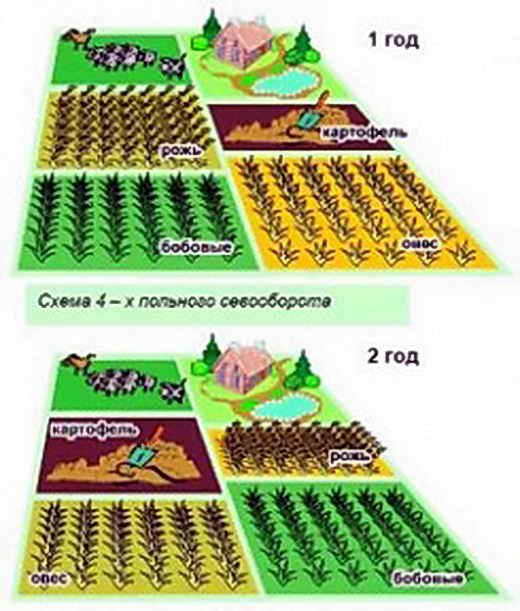
1. Let the soil rest. Plants growing annually in one place draw certain nutrients from the soil, over time they become less and gradual depletion begins, the crop is reduced. When you replace one crop with another, while applying top dressing, soil resources are restored, while giving away other nutrients.
2. Destroy pests naturally. During the summer season, pests and pathogens characteristic of plants appear in the soil. By alternating vegetable crops of different families, these pests and diseases will not be dangerous, and in a few years there will be no trace of them at all. So, growing onions for several years in a row in one place, nematodes appear in the soil, and cabbage has a disease.
3. Loosen the soil and enrich with trace elements. A culture with long roots (buckwheat, rapeseed) will make dense soil looser, and will also be able to get phosphorus, potassium, calcium to the surface from the depths, so planting a crop with small roots in the same place next season will not require additional feeding of that or other micronutrient.
4. Legumes (beans, peas) enrich the soil with useful fertilizer - nitrogen. It is formed and accumulates in the nodules of plants, which are left in the soil when cutting the tops. By the way, clover will enrich the soil with nitrogen 2.5 times more than peas, and alfalfa 5 times.
5. Garlic, onions and carrots are best planted after pumpkin, tomatoes, cabbage or potatoes, i.e. where weeds will be the least.
The crops to be replaced must not be of the same family.
On well-cultivated soil with a rich content of micro and macro elements, it is better to plant tomatoes, cucumbers, celery, and cabbage. These are those vegetable crops that pull useful substances from the soil in large quantities. And in beds with a small amount of compost, it is better to plant legumes and root crops.
By alternating vegetables of different families every year, you will already create the simplest crop rotation scheme, thus increasing yields. Let's give an example of zoning crops in a small area:
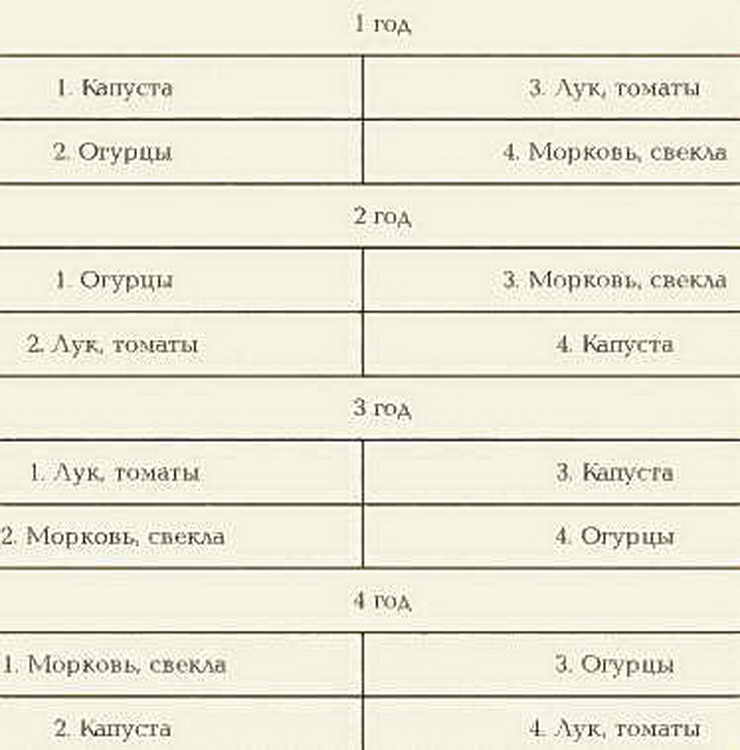

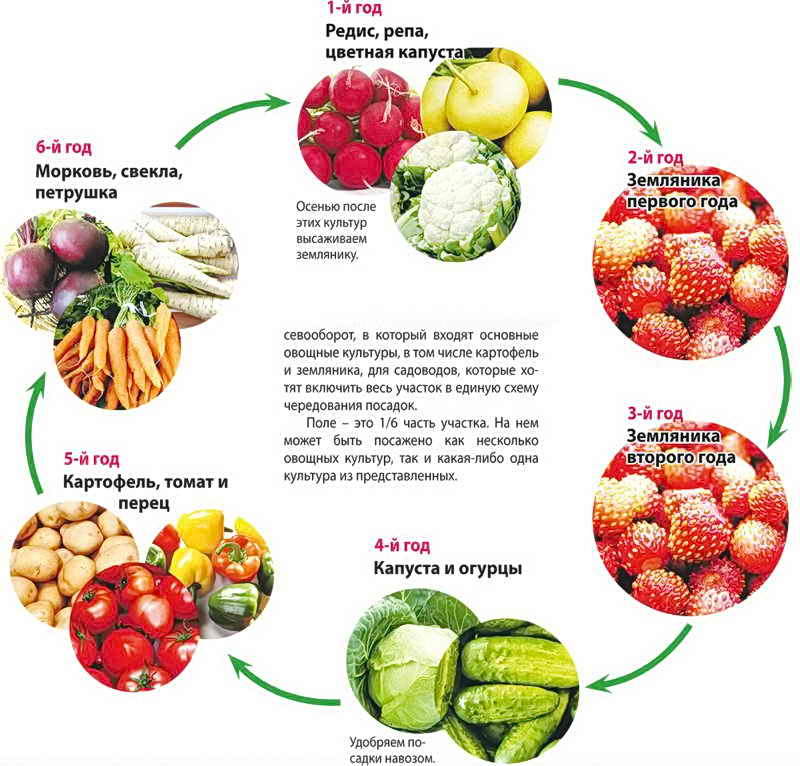
 If it is difficult to maintain a planting plan, then in order not to get confused, act according to the principle of an annual change of beds with roots (root crops) to a bed of inches, then what grows on the surface of the soil.
If it is difficult to maintain a planting plan, then in order not to get confused, act according to the principle of an annual change of beds with roots (root crops) to a bed of inches, then what grows on the surface of the soil.
In a crop rotation, crops can be combined, taking into account the ripening period. Plant cucumbers in 2 rows at a distance of 50 cm between them, and in the aisle and along the edges of the beds dill in a single line.
Corn is not a demanding crop and does not participate in the crop rotation system; it is a neutral predecessor to other vegetables. When planting vegetables, keep in mind what accumulates under corn.
In a small area, it is quite difficult to observe crop rotation in full, therefore good decision will be autumn sowing.
Crop rotation table in the country
| Plant | The best predecessors | Bad predecessors |
| Potato | Cucumbers, cabbage, onions, zucchini, pumpkin, beets, garlic, squash, garlic, peas, beans, green manure | Carrot, sunflower, tomato, early potato, pepper, eggplant |
| Tomato, pepper, eggplant | Cucumbers, pumpkin, zucchini, turnip onions, cabbage, squash, greens, turnips, carrots, green manure | Tomato, early potato, pepper, eggplant |
| Cucumbers, zucchini, pumpkin | Celery, potatoes, leeks, garlic, beans, cauliflower, peas, corn | pumpkin, late cabbage, tomato, carrot, turnip, pepper, eggplant |
| White cabbage | Turnip onions, carrots, potatoes, peas, beans, beans, cucumbers, zucchini, pumpkin, squash | Beets, cabbage |
| Cauliflower | Cucumbers, tomato, pumpkin, zucchini, patisson, onion, garlic, peas, beans, green manure | Beets, cabbage, early potatoes |
| Carrot, turnip | Cabbage, tomato, potatoes, cucumbers, pumpkin, squash, | Beet |
| Beet | Cucumber, pumpkin, zucchini, tomato, basil, mint, early potatoes, greens, green manure | Beets, cabbage |
| Garlic, onion | Tomato, cauliflower, cucumbers, zucchini, pumpkin, beets, early potatoes, peas, beans, green manure | onion, Chinese cabbage, spinach, dill, carrot, turnip, basil, coriander, mint |
| Peas, beans | Cabbage, cucumbers, pumpkin, patisson, onion, garlic, potatoes | Peas, beans, corn |
| Strawberry | Onions, garlic, dill, carrots, celery, peas, beans, corn, green manure | Cruciferous (mustard, cabbage, horseradish, radish, swede, radish, lettuce), nightshade (tomato, pepper, eggplant, petunia, brugmansia, potato, tobacco, dope), raspberry |
| Dill, spinach, onion on greens | Celery, radish, tomato, carrot, cauliflower, cucumbers, patisson, pumpkin, onion, garlic, peas, beans, green manure | cabbage, carrot, turnip |
Mulching is good
Humus is the source of soil fertility
Plants enriching and improving the soil, the use of green manure
Crop rotation of vegetable crops is a necessary alternation of grown plants in your beds. Crop rotation in the garden should ideally be annual and continuous. This means that nothing should grow in the same place for two or more years in a row! This, of course, is ideal, and not every summer resident is able to realize such a utopian picture. However, "Gardener and Gardener" will try to help you in this difficult matter.
We have prepared unconditionally useful diagrams and tables for you, which you, as usual, can download from the link at the end of the article. For now, let's get to the theory.
Crop rotation of vegetable crops: a table for busy gardeners
In general, a crop rotation device is not a fast occupation and requires a certain amount of time. This is due to the fact that when alternating crops, quite a lot of factors must be taken into account: the need for a plant in nutrition, belonging to a biological family, contamination of the soil by pests, etc. For those who do not have enough time for long calculations and construction of schemes, we offer a quick and easy solution.
"Crop rotation table: successors and predecessors of vegetables when planting" will help you navigate the choice of a plant for a particular bed, without delving into the details. The only thing to remember when using it is that the culture can return to its original place after at least 3 to 4 years.
Crop rotation table: successors and predecessors of vegetables when planting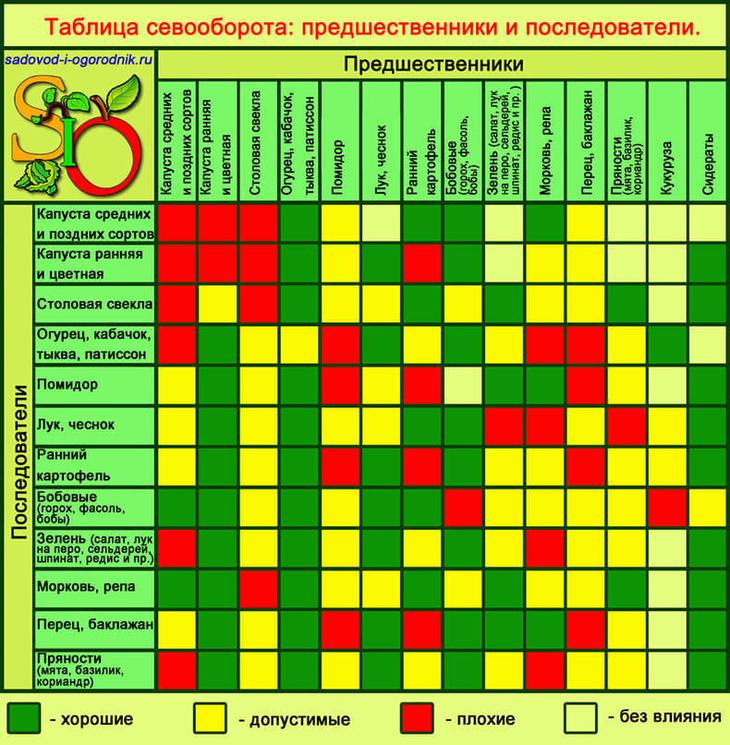
As you can see from this crop rotation summary table, there are the best vegetable crop predecessors, acceptable and bad:
The best predecessors of tomatoes are cauliflower and early cabbage, cucumbers, zucchini, pumpkins, greens, carrots and green manure. It is permissible to plant tomatoes after onions, garlic, herbs, beets, cabbage of late and medium varieties. After other crops, planting tomatoes in the garden is no longer worth it.
Remarkable predecessors of cabbage are cucumber, zucchini, pumpkin and legumes. And here comes the division. For late and medium varieties, early potatoes and carrots are good, and for early and cauliflower it is better to sow after green manure and onions with garlic.
Good predecessors of onions and garlic (which you do not grow for greens) are cauliflower and early cabbage, cucumbers, zucchini, pumpkins, early potatoes, peas, beans, beans and green manure.
The best predecessors of cucumbers, zucchini, pumpkins, etc. are onions, garlic, legumes, corn, early and cauliflower.
Good predecessors of peas are any cabbage, early potatoes, cucumbers, zucchini, pumpkins and squash.
Excellent predecessors of carrots are cabbage, potatoes, herbs and spices, zucchini and green manure.
The best predecessors of pepper and eggplant are cucumbers, onions, carrots, green manure, etc.
Good predecessors of beets are spices and herbs, potatoes, cucumbers, etc.
Remarkable predecessors of potatoes are zucchini, garlic, legumes, green manure, etc.
It seems that you managed to figure out how the table works without much difficulty. So, the “hurry-ups” leave us, and we move on.
Crop rotation of vegetables in the beds: a necessity or a whim
For those summer residents who are not limited in time, the "Gardener and Gardener" offers to "dig deeper." To begin with, let's look at the objective reasons that speak of the undoubted practical benefits and the need for crop rotation in the country.
Causes of soil fatigue:
1. Accumulation of pests and pathogens.
If you plant for a long time in the same place, for example, potatoes, then the number of wireworms, Colorado potato beetles and late blight pathogens will inevitably increase in this area. The same is true for other cultures. Growing the same vegetables all the time on the same beds, you run the risk of getting on one dominance of onion flies, on the other cabbage keel, on the third carrot fleas, etc. What can we say about root and leaf nematodes, rot and other "minor" troubles.
2. Accumulation of toxins.
Another reason that speaks of the need for vegetable crop rotation is the inevitable toxic root secretions - colins. Many vegetables are very sensitive to their own toxins. If you continue to plant them in one place, then the crops will get worse and worse every year, even despite the absence of pests and diseases. So, for example, spinach and beets are most susceptible to their root secretions. Parsley, radish, radish, celery, carrots and pumpkin crops react a little easier to them. Corn, leeks and legumes are the least affected by colin. A lot of toxins remain in tomato, cucumber, carrot and cabbage beds.
3. Nutritional needs.
The supply of nutrients on the site is not unlimited. Each plant has its own nutrient requirements. Some cultures are less demanding, while others are more. Therefore, it is very important to know "who is who" in order to track the state of a particular bed. So if related plants are planted in the same place, then in a few years they will “suck out” everything necessary for growth from it, depleting the supply of some elements. As a result, productivity will drop.
All these factors together give the so-called soil fatigue. You can and should fight this. Most effective remedy- this is the crop rotation of vegetables at your dacha.
Crop rotation in the garden: the fight against soil depletion
In order for the horrors described above not to become a reality in your favorite dacha or plot, it is enough to remember and adhere to three simple rules crop rotation.
1. The rule of botany.
You should never plant not just the same plant one after another, but even related crops belonging to the same species! This is the first, most important and important.
Judge for yourself:
- Diseases and pests are most often the same. Therefore, the first reason will not be eliminated.
They also have similar toxins. Colins of one plant are processed only by cultures of another botanical species. So the second reason will remain in place.
- Nutrition and the need for trace elements in crops of the same family are also almost identical. It turns out that the third reason is not going anywhere.
Conclusion: crop rotation of vegetables within the same botanical family is useless!
2. The rule of time.
The longer the culture does not return, the better!
The minimum period after which you can return the plant to its original place is 3 years. For carrots, parsley, beets, cucumbers, it is better to increase it to 4-5 years. Cabbage, when the keel appears, can be returned only after 6-7 years. If there is an opportunity (there is enough space, many crops are grown), then feel free to increase these numbers, it will only get better.
Otherwise, the same three causes of soil fatigue will not be eliminated again.
3. The rule of fertility.
When determining the rotation order of crops in a crop rotation, remember about nutrition and about plants that help enrich the soil with the right elements.
All crops use nutrients to grow, some more, some less. Plants that are very demanding on nutrition should not be planted one after another.
Some cultures improve the fertile layer by the very fact of their growth in this place. These include almost all legumes. They not only loosen the soil, but also fill it mineral elements. No wonder many vegetables love them as predecessors. By the way, plants of other species have similar qualities, in which the root system is deep, powerful and developed.
Others contain the necessary substances in their roots and leaves. These plants need to be known and, if possible, laid in compost. Although this is a separate topic, we will still give a few examples.
Buckwheat and melon leaves - calcium,
- dope leaves - phosphorus,
- stems and leaves of tobacco - potassium,
- Dioecious nettle - iron.
In accordance with this rule, we advise you, when drawing up the order of alternation of crops in a crop rotation, pay attention not only to the botanical appearance and timing, but also to the exactingness of nutrition and the improvement of fertility. Thus:
- after each plant that is demanding on nutrition, next year it is worth planting legumes or seriously fertilizing the garden,
- after a less demanding vegetable, you can plant a more demanding one, moderately fertilizing the soil.
To make it easier to navigate when alternating crops in a crop rotation, "Gardener and Gardener" has prepared a special memo for you.
Memo: "What to consider when alternating vegetable crops in a crop rotation"
The scheme of crop rotation of vegetables in the country
Giving some options for crop rotation schemes is a waste of time. The summer cottage of each gardener is unique, which means that some standard crop rotation plans can suit few people. And it's not even about the size of the plot or the number of beds. It's just that the vegetable crops that are cultivated are different for everyone. Someone plants a lot of cabbage of different types, and someone literally 5-6 plants. Someone plants potatoes for 5 acres, while someone needs 5 square meters. meters. Someone plants many crops in a greenhouse, while someone has a greenhouse only for tomatoes and cucumbers. Therefore, it is more expedient for each summer resident to independently plan crop rotation and draw up individual schemes for himself.
The basic principles that should be followed are outlined above. Now let's move away from the ideal and plunge into reality. Further, "Gardener and Gardener" offers you a list of practical tips on crop rotation.
Crop rotation for suburban area: practical advice
1. Human memory is not unlimited. To remember what kind of vegetable sat on this bed five years ago is an impossible task for most summer residents. Therefore, the first advice is not to be lazy and draw up a plan of your site with all the beds in a notebook. On this plan every year you will mark the planted crops. Those who have a lot of free time can immediately mark plants that are likely to be planted a year, two or three years in advance. The rest, in order to compile a complete crop rotation map, will take 5-6 years (according to the number of average time for the return of a crop).
2. In the process of sowing, decide and write down in your notebook how much space which crop takes up for you(a third of the beds, a quarter, a half, a whole, etc.). This is necessary so that in the next years it will be possible to “fold” suitable plantings, like pieces of a mosaic. After all, it is not necessary to sow the entire garden with any one crop. If you can plant cabbage and greens after onions, do so - half a bed of one, half a bed of the second. Just do not forget to make sure that the neighboring plants are compatible.
3. If you can’t change the place of a culture(well, it happens), don't despair. Just add a "neighbor" from another family to it on the bed (do not forget to check the compatibility table). So self-poisoning plants (beets, spinach, carrots, etc.), which we talked about in the second reason (Accumulation of toxins), can grow in one place quite calmly and without loss in yield up to 3 years. After all, neighbors of a different species are well processed and absorb their destructive toxins. Mixed fit works better when it's really mixed. That is, not half a bed of beets and half a bed of carrots, but a row of one, a row of another. Or better yet, fill the aisles with the same beans.
Here, perhaps, is all the information that you need to organize a correct and efficient crop rotation in the country. The table will help you quickly determine the crop to be sown. Reminder - plan everything in advance. Practical advice - to solve the problems that arise in the process. Have a good harvest!
To grow good harvest vegetables, many activities need to be carried out, which include tillage, watering and weeding. But no less important is crop rotation in the garden. Crop rotation is the alternation of plants on the site. The crop that was grown last year is called the predecessor.
By observing crop rotation, you can significantly increase not only the yield of vegetable crops and soil fertility, but also reduce the likelihood of pests and diseases. Over the long years of the development of agriculture as a science, experts have determined a favorable alternation of plants on the site.
Crop rotation has long been proven effective in industrial agriculture. Such a measure allows the soil to restore the content of individual microelements, and farmers to use fertilizers more efficiently. Planting vegetables in one place for several years contributes to the depletion of soil nutrients, the accumulation of infections and an increase in the number of pests. The main task Crop rotation is the preparation of the precursor soil for the subsequent crop. Optimal for the garden is a crop rotation for three years. That is, each culture returns to its original place after three years.
Drawing up a crop rotation
Before applying the alternation of vegetable and other crops on your site, you need to draw up a plan for the garden. In a small area, it is very difficult to follow all the rules of alternation, but you can try to bring your crop rotation closer to the correct one. In order not to get confused next year about what and where it grew, you need to draw a detailed diagram of the garden. It reflects all the beds of vegetables, the area occupied by potatoes. Next year, according to this scheme, it will be easy to determine which plants and where to plant.
You can do it in another way.
- The garden is divided into 4 parts and planted on each plot of crops that have similar nutritional requirements. For example, in plot number 1 - zucchini, cucumbers and cabbage.
- To plot number 2 - tomatoes, eggplants, onions and garlic.
- Plot number 3 - radishes, turnips and other root crops.
- Potatoes are planted on the fourth plot. These areas are changed every year.
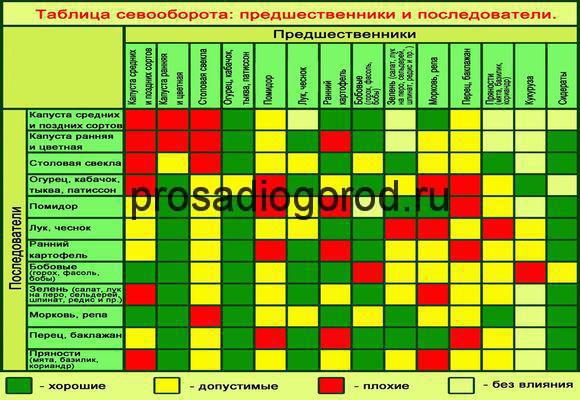
The third method of compiling a crop rotation of vegetable crops in the garden involves placing plants from the same family on each plot:
- legumes;
- cruciferous;
- pumpkin;
- onion;
- nightshade.
Due to this placement, the depletion of the soil area is reduced. There is another simple rule for those who are afraid to get confused in the alternation of vegetable crops - every year they change tops for roots. That is, one year vegetables are grown on the site, the crop of which is formed in the ground, and the next year - vegetable crops with above-ground fruits.
Using these methods, you can easily and efficiently place all crops even in a small area and alternate them.
Rotation table
Crop rotation according to all the rules is actively used by agricultural enterprises. In the course of many years of field experiments, good predecessors and a favorable alternation of crops were identified. Legumes, in particular peas and beans, are considered universal predecessors.
Due to the peculiarities in the activity of the root system, they accumulate nitrogen, which has a positive effect on the growth of crops.
Agronomists at agricultural enterprises prefer to grow wheat and other cereals after legumes and vegetables. Since their productivity increases significantly. Potatoes are good predecessors, after which root crops, cabbage and tomatoes can be planted.

The following year, after onions, root crops, potatoes and legumes are suitable. Greens are a good precursor for potatoes, legumes and pumpkins, and cucumbers for tomatoes, root vegetables, potatoes and cabbage. And after root crops, cabbage, tomatoes and potatoes grow well.
Undesirable followers for cabbage are radish, radish, pumpkin. For onions - celery, carrots and other types of onions, and beets - spinach and tomatoes.
Based on the favorable location of crops after the predecessors, a crop rotation table is compiled. The table consists of three columns - the predecessor is noted in the first, and the crop that will grow in this place for the next year is written in the subsequent ones. The number of rows in the table depends on the number of crops that participate in the crop rotation. Typically, a crop rotation is made for three years, but it can be done for five years.
By correctly compiling a crop rotation for your garden, you can get a very good harvest, reduce the amount of mineral fertilizers that affect the composition of the soil, and allow the soil to restore its reserves of substances after each crop is grown.
Sometimes plants year after year do not give the harvest that we expect from them, they “overgrow” with diseases, lose their taste.
We apply tons of fertilizer, but to no avail. All the fault may be non-compliance with the rules of crop rotation!
Ideally, crop rotation should be annual and continuous, otherwise the so-called soil fatigue will occur on your site, which is always combined with the accumulation of pests and diseases, toxins and reduced fertility.
Let's take a common potato.
If you plant it every year in the same place, the army of wireworms, Colorado potato beetles, will inevitably increase. The same applies to other cultures: onion fly, carrot fleas, nematodes - from year to year there will be more and more of these misfortunes, because they will always be able to feast on their favorite "treat" in their usual place.
Toxins also accumulate in the soil - they are secreted by the root system of vegetables (leaders are cucumbers, tomatoes, carrots and cabbage).
Sometimes just a couple of years of planting on the site of the same plant leads to severe depletion of the land. Not all elements, of course, but only those that are most needed by a particular culture. Getting to the site again and again, the plant will feel their acute shortage and starve, losing the crop.
All these troubles can be easily avoided by knowing a few simple crop rotation rules.
1. Botanical crop rotation rule
Do not plant related crops in the same place year after year. They are affected by the same diseases and pests, suffer from similar root toxins. Nutrition and the need for trace elements are also almost identical.
2. The rule of time
Do not return the vegetable to its original site for a longer time. Usually, plants can be planted in the same place after 3 years, some - after 5 years (carrots, beets), and there are generally "crops of the same garden" that are best planted in the same place no earlier than after 7 years, for example, cabbage.
Crop rotation of vegetable crops: table
| culture | Good predecessor | Medium predecessor | Bad predecessor |
| Watermelon, | Siderates, legumes, onions, cabbage | Beets, green | Sunflower, potato, pumpkin |
| Eggplant | Cabbage, onion, carrot, cucumber, beans, green manure | Beet | Solanaceae: Potato, Tomato, Eggplant, Tobacco, Pepper, Physalis |
| Peas | Cabbage, cucumber, tomato, potato | Greens | Legumes: soybeans, beans, peas, beans, lentils, chickpeas |
| zucchini, squash | Siderates, radishes, onions, cabbage, carrots, parsley, greens | Beets, green | Pumpkin |
| Cabbage | Siderates, carrots, potatoes, onions, legumes, cereals, cucumber, zucchini, pepper, celery, pumpkin, squash | tomato, lettuce | Beet, turnip |
| Onion | Siderates, tomato, beans, peas, cucumber, potatoes | Cabbage, beets | Garlic, carrot |
| Carrot | Cucumber, zucchini, onion, potato, tomato | Beets, cabbage, radishes | Parsley, carrots, beans |
| Cucumber | Siderata, cabbage, onion, tomato, celery | Beets, green | Pumpkin |
| Pepper, tomato | Cucumber, cabbage after green manure, onions, carrots, beans | Beet | Beans, nightshade |
| Parsley | cucumber, tomato | Potatoes, beans, onions | Carrots, parsley, celery, parsnips |
| Radish, | Potatoes, beans, cucumber, tomato, peas, carrots, beets | Onion | Rutabaga, cabbage, radish, radish, turnip |
| Beet | Cucumber, onion, potato, tomato, beans | Peas | Beets, chard, carrots, cabbage |
| celery | Cabbage, tomato, cucumber | Legumes, onions | Carrot, parsley, celery |
| Garlic | Siderates, cabbage, potatoes | Cucumber, beetroot, tomato | Onions, garlic, carrots |
| potatoes | Siderates, beets, cabbage | Onions, carrots, green | Solanaceae: potato, tomato, eggplant, tobacco, pepper, physalis |
The use of crop rotation - the experience of summer residents and gardeners
Neighbors and predecessors are extremely important for any garden crop. People can still somehow agree among themselves, but plants will suffer if their likes and dislikes are not taken into account.
I am a proponent of organic farming. Of course, you can not refuse mineral fertilizers, you just need to remember that their excess leads to a decrease in the quality of the crop and causes the death of beneficial microorganisms in the soil. From organic matter, I use manure, compost, ash, bird droppings and, of course, green manure. Manure - rotted and in liquid dressings, I dilute the litter with water. The ash contains 30 trace elements and reduces the acidity of the soil, I apply it both to the soil and to the compost heaps, of which we have two.
Green manures enrich the soil with organic matter, nitrogen, microelements, and their roots loosen the soil and improve its structure. I cut them off with a flat cutter and leave them in the garden as mulch or embed them in the soil by 2-3 cm. In order for the soil to recover faster and become more fertile, I advise you to change green manure every year. D I only water warm water, and until mid-summer, only snow or rain, as well as green fertilizer.
I prefer to grow vegetables in high beds, the benefits of which have been said a lot on the pages of our magazine. And in 2006, the high beds saved my harvest in general: there was a heavy downpour, and an avalanche of dirty water with stones went from the city to our plots (they are lower than the city streets), sweeping away everything in its path. The photo shows that my beds remained intact.
A little about digging the soil: I completely agree with V.P. Verbitsky that you need to dig shallowly, especially those beds where vegetables with a long root crop (carrots, daikon, parsley, etc.) will be sown. Thanks to our magazine, I have been familiar with the shovel with an emphasis since 2010.
In the crop rotation diagram, the arrow shows the movement of each plant from one field to the next. To do this, divide your entire sown area into five fields. For example, field 1 - cucumbers, zucchini are planted from the 1st bed. This is the 1st year. In the 2nd year, tomatoes and peppers are planted; on the 3rd - carrots, onions; on the 4th - potatoes; on the 5th - cabbage. Thus, each plant returns to its place after five years.
Plant groups:
1 - cucumbers, zucchini, greens, legumes, beets;
2 - white cabbage, cauliflower;
3 - potatoes;
4 - carrots, onions, parsley, onions on a feather;
5 - tomatoes, eggplants, peppers.
Groups can be supplemented with other cultures if they are compatible and useful to each other as predecessors.
I often have to deal with the careless attitude of some landowners to crop rotation in my line of duty. Naturally, I won’t be able to explain the importance to everyone, but I can write about it so that the inhabitants of towns, villages and villages can read and draw conclusions (especially for the younger generation without agricultural experience).
I'll start with the worst, namely the consequences of non-compliance with crop rotation.
Having no experience, but having a desire to grow with my own hands vegetables and fruits, we often make gross mistakes. And this happens in most cases like this: you drew a plan on paper and made it a reality, that is, you transferred it to the ground. You would not want to change anything at all, because, as it seems to you, perfect place found under potatoes, cucumbers or tomatoes. For several years in a row you work tirelessly, water, fertilize, and the harvest, instead of increasing, becomes smaller and smaller every year. Isn't it embarrassing?
And all because it is impossible to successfully grow the same crops in the same place. The soil is depleted over time, the number of pathogens and pests in the soil increases, even epidemic outbreaks occur. That is why crop rotation cannot be ignored.
Each group of vegetables, and there are 4 in total, has its own soil requirements, and the task of the grower is to correctly plan the planting.
The first group includes demanding vegetables that need to be provided with a large amount of nutrients. To do this, annually in the spring and then regularly during the growing season, complex mineral fertilizers and compost. Cabbage, pumpkin and Compositae crops are considered demanding.
The second group is medium-demanding crops. These include flowers such as calendula, marigold, nasturtium, purslane. Also, tomatoes, potatoes, eggplant, peppers, physalis are considered medium-demanding. It is enough to feed these crops once at the beginning of the season and also feed once a month.
Onion, umbrella, haze: parsley, bush beans, onions, basil, tarragon, marjoram, savory, mint, parsley, parsnips, as well as beets, chard and carrots will grow well without additional feeding.
The fourth group includes legumes, which accumulate nitrogen from the air. Due to this property, they improve the structure of the soil, since the content of humus and beneficial microorganisms in it increases.
The landing scheme might look something like this:
Legumes Demanding crops Undemanding crops Medium demanding crops.
The site is divided into 4 parts, each of which is planted with one of the groups of crops at your discretion. In the second year, the plantings shift, for example, clockwise, as a result, after 4 years, each group will visit each of the sites.
And do not be embarrassed that the flowers will be together with vegetables, but your soil will not be threatened with depletion.
: Predecessors and neighbors: choosing the best ...
Crop rotation- the correct alternation of fruit and berry and vegetable crops in a certain area. The main tasks of this process:
- Preservation of soil fertility;
- Increased yield;
- Reducing the likelihood of diseases of crops.
In order for horticultural crops to please with their harvest from year to year and not get sick, you need to adhere to the crop rotation scheme.
Let's explain in more detail. According to the rules of botany, it is impossible to grow a plant every year in the same place. This is due to a number of reasons.
Firstly, any crop, whether vegetable or berry, tends to take certain microelements from the soil. If you do not follow the rules of crop rotation, then the land will be depleted and lose its fertile properties.
Secondly, when growing a certain vegetable crop in the same area, pests appear in the soil, which, when re-planted, will damage it.
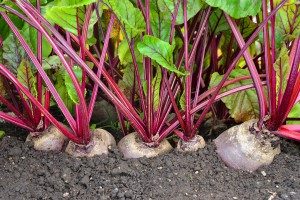 Observations have shown that the correct plant rotation allows even distribution of microelements in the soil.
Observations have shown that the correct plant rotation allows even distribution of microelements in the soil.
Today there is list, which determines the order of planting, both vegetable and berry crops.
Best and worst predecessors:
- Onion (bulb), garlic. Do not plant after carrots. Good predecessors for these crops are: cabbage (early or cauliflower variety), zucchini, potatoes (early), pumpkins, legumes (beans and peas)
- Carrot and parsley. They grow well after any varieties of cabbage, greens (except lettuce), potatoes. You can not place a bed where carrots and parsley have already grown for 2-3 years
- Cucumbers, zucchini and pumpkins. These crops are usually planted after cauliflower or early cabbage, onions, garlic. Also, such predecessors as potatoes, beets, peas and greens (lettuce, dill) are not forbidden. It is not recommended to plant the above vegetables from the pumpkin family, where cabbage (late varieties), carrots, and tomatoes grew
- Cabbage, radish, turnip. For the listed vegetable crops, it is customary to allocate a new bed every year. You can not plant 2 years in a row in the same place. Consider good predecessors: potatoes, tomatoes, onions. It is permissible to plant in the place where there used to be beans, peas, carrots and beets
- Tomatoes. It is also desirable to plant tomatoes in a new place each time. Well, this culture grows after cucumbers, turnips, cauliflower, greens. It is forbidden to plant tomatoes where potatoes used to grow
- Potato. An excellent crop of potatoes can be harvested if planted after legumes and grains, cabbage, pumpkin, cucumbers, beets and greens. Tomatoes are bad predecessors. It is very important not to place potatoes in the same place for 2 years in a row, in order to prevent the Colorado potato beetle.
- Beet. In the list of excellent predecessors: cucumbers, potatoes (early) and greens. It is also allowed to plant beets after cabbage (cauliflower or early variety), onions, tomatoes and carrots. It has been noticed that beets grow poorly and get sick if they are planted in the place where they grew last season.
- Eggplant. You can safely plant after cucumbers, onions, early-ripening cabbage varieties, perennial herbs(lemongrass, mint, etc.). Worst predecessors: potatoes, tomatoes, peppers and eggplants. (By the way, about how to plant eggplant seedlings, read
- Corn. The plant is unpretentious. It is not demanding of predecessors. Grows well in place of legumes, but can be sown after any other crop
- Green crops (, mustard, lettuce, radish, sorrel, etc.). They bring a good harvest after legumes, cabbage (early and cauliflower), cucumbers, onions and garlic. Bad predecessors are carrots and late varieties of cabbage.
Crop rotation of fruit and berry crops
 When growing fruit crops crop rotation rules are not cancelled.
When growing fruit crops crop rotation rules are not cancelled.
Here, too, one should try to alternate subsequence planting plants:

Crop rotation of flower crops
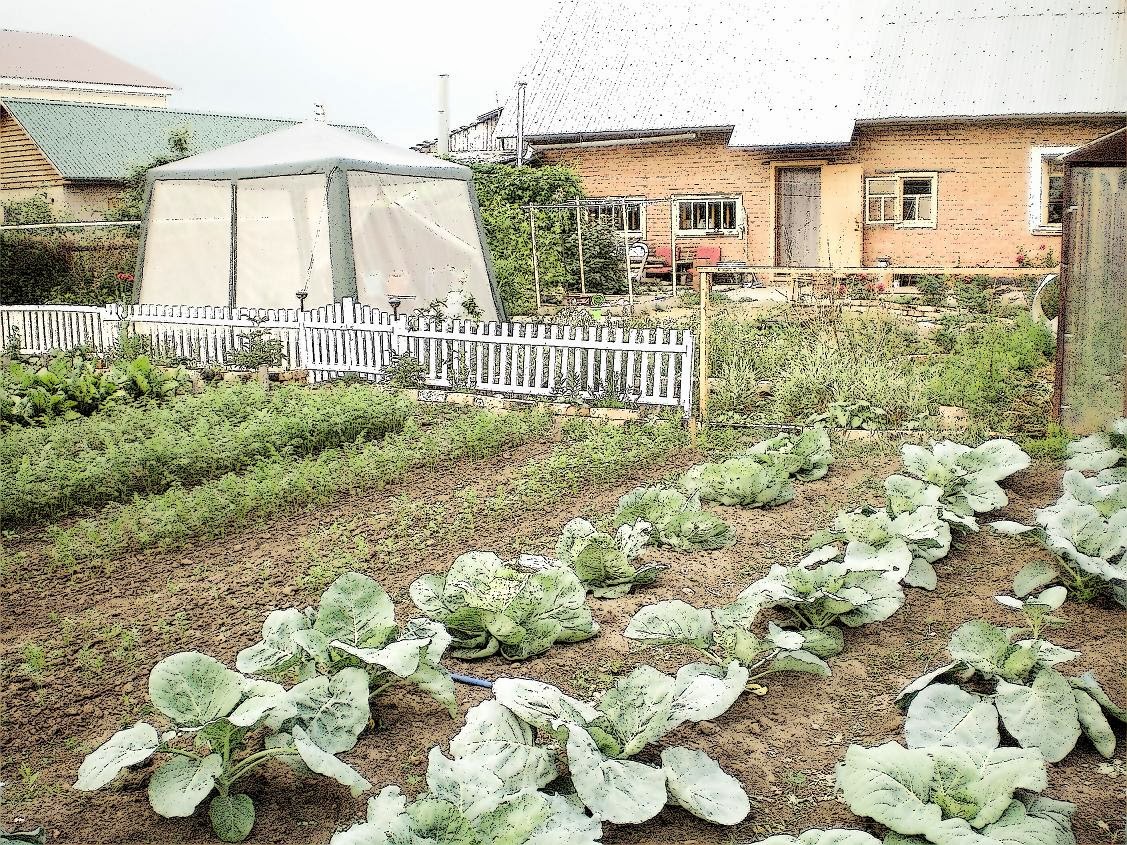 It is noteworthy that the crop rotation includes flower cultures.
It is noteworthy that the crop rotation includes flower cultures.
Some varieties of flowers are usually planted after vegetables, others are not demanding at all and can grow well in one permanent place:

Crop rotation scheme at their summer cottage
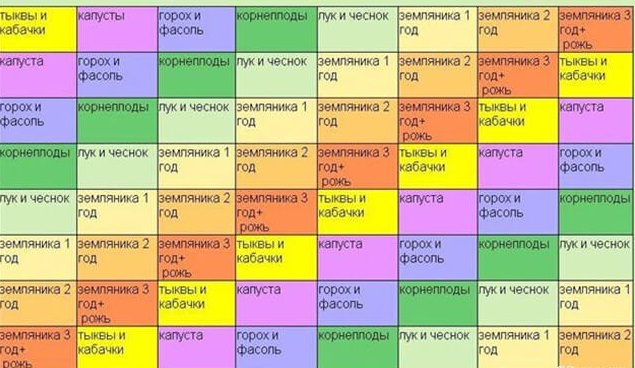
For successful cultivation in the summer cottage of vegetable and fruit crops, experienced gardeners recommend drawing up your own plan for several years ahead crop rotation scheme.
- The very first thing to do is to mentally divide the site into four sectors(in no particular order)
- In the first potatoes should be planted, as well as vegetable crops sensitive to frost (zucchini, cucumbers, tomatoes, etc.)
- Second sector can be taken for any root crops (carrots, radishes, beets, etc.)
- It is permissible to place cruciferous crops on the third site ( different types cabbage), and on the fourth legumes, onions and garlic.
